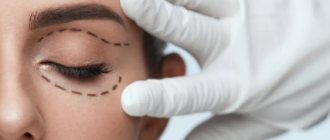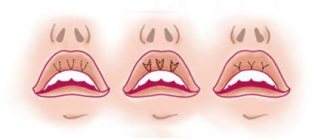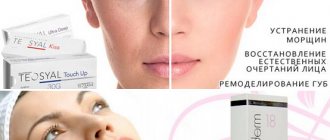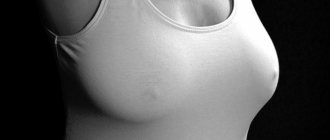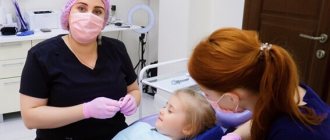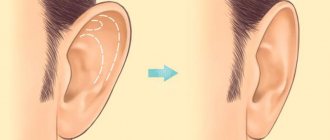Recently, blepharoplasty of Asian eyelids has been gaining popularity - an operation to Europeanize the eyes among people of the Eastern type. This operation allows you to correct the features of the Mongoloid eyelids, making the look more open and expressive. Sometimes this operation is also called “Singapuri”.
I have extensive experience in performing Asian eyelid surgery, I have my own proprietary technique, and my patients are very pleased with their appearance after surgery. I invite you to read the results of the operations, reviews of blepharoplasty for Asian eyelids and learn more about the operation itself.
The patient underwent surgery to Europeanize her Asian eyelids. This result is presented 1.5 months after surgery.
What is an Asian eye shape?
The Asian eye shape is a shape characteristic of representatives of the Mongoloid race. Being a dominant feature, the incision is characterized by a narrowed palpebral fissure, the presence of skin folds in the corner of the eye (epicanthus) and the almost complete absence of the so-called supraorbital folds - a double fold on the upper eyelid.
The Asian cut differs from the typical European cut by thickened eyelid skin, the presence of a large amount of orbital fat and high-set eyebrow arches. The Asian structure of the palpebral fissure is transmitted genetically, but can also occur in people of other races. As a rule, this is the result of previous injuries, as a result of which the epicanthus was formed, age-related changes, or in people suffering from Down syndrome.
What is the result of plastic surgery?
Contrary to popular belief, a plastic surgeon cannot change the shape of the eyes. But during correction, excess fatty tissue is removed, a fold is formed on the eyelid and the epicanthus is straightened. Taken together, this makes it possible to make the appearance close to European. The eyes visually become more open and larger, the gaze becomes more expressive.
The operation is quite simple, recovery is very fast. You can leave the clinic on the day of the intervention. It will be possible to return to normal life in the near future, provided that the patient strictly follows all the doctor’s recommendations. Complications occur rarely; in most cases they are a consequence of the surgeon’s insufficient qualifications or the patient’s failure to comply with rehabilitation rules. With the right choice of doctor and a responsible attitude towards your health during the recovery period, the effect of the operation will be as high as possible and will last for a long time, ideally for a lifetime.
How is Asian eyelid surgery performed in Moscow?
In most cases, I perform blepharoplasty of the eastern eyelids under local anesthesia, but there are cases when this is not enough and general anesthesia is required.
The entire plastic surgery can last from one to two hours.
The peculiarity of this area of blepharoplasty is that the surgical intervention consists of three main mini-operations
Removal of the fold of the inner corner of the eye or epicanthus . The sutures are hidden along the new line of the canthal angle.
Reduction of the upper eyelid . It is carried out by eliminating part of the subcutaneous fatty tissue or hernias above the eyes. As a result, the eye becomes visually larger. In older women living in Asian countries, in order to achieve a more visible change and create a beautiful European eye shape, more skin has to be cut off during the procedure.
Formation of a fold in the upper eyelid . To make a new fold, the plastic surgeon securely fixes it using a neat cosmetic suture. (The peculiarity of the Asian eye shape is that it is distinguished by the absence of this fold)
How is the rehabilitation going?
Rehabilitation proceeds in the same way as with classic blepharoplasty.
The swelling and bruising intensify in the first days, and then within ten days they practically disappear.
Since the operation to change the eastern type of eyes is quite serious, it is very important to conscientiously follow the surgeon’s recommendations during the rehabilitation period. This means that the first two weeks you need:
- Avoid physical activity
- Do not visit the bathhouse, sauna or solarium
- Do not watch TV for a long time or sit in front of the computer
- Don't drink alcohol
- Don't smoke and so on.
Full recovery occurs 1.5 – 2 months after surgery.
Are complications possible after Asian eyelid surgery?
In general, complications do not arise, but it is possible that the patient may violate the rules of behavior during rehabilitation, which will lead to:
- Increased swelling and hematomas
- Seam divergence
- Bleeding
- Scar dehiscence
- Dry eyes and so on.
How the operation is performed
Correction of Asian eyelids is slightly different from classic blepharoplasty. There are two correction methods: with and without an incision. In the first method, the doctor makes a small incision on the upper eyelid, removes excess fat and skin, then forms a fold of the eyelid at the site of the incision and applies sutures. Epicanthus plastic surgery is performed and, if necessary, hernias under the eyes are removed.
With the no-incision technique, work is done from the inside of the eyelid. Small sutures are placed on the mucous membrane, with the help of which a fold of the upper eyelid is formed. Epicanthus plastic surgery is also performed. The correction differs from the previous type by a lower risk of complications and a short rehabilitation period. But this technique can only be recommended for slight drooping of the eyelid.
There are two types of techniques for performing sangapuri.
Preoperative preparation
Before the operation, the following measures are necessary:
- Consultations and examination by specialists - plastic surgeon, therapist, ophthalmologist, cardiologist and anesthesiologist;
- Passing all laboratory tests;
- Undergoing a hardware examination of the body - ECG, ultrasound, etc.
In addition, the patient must strictly adhere to the following recommendations:
- 3 weeks before the correction, stop taking aspirin , hormonal drugs and all blood thinning medications;
- 1.5 - 2 weeks before surgery, stop taking alcoholic beverages and tobacco products .
Contraindications
The operation is not possible if you have the following health problems:
- Exacerbation of chronic diseases of the heart and blood vessels.
- Diabetes mellitus of any type.
- Ophthalmological diseases (glaucoma, blepharitis, conjunctivitis, cataracts, keratitis, dry eye syndrome and other vision disorders).
- Low blood clotting.
- Inflammatory processes on the skin of the face.
- Dermatological diseases.
- Infectious and viral processes.
- Venereal diseases.
- Disruption of the functioning of the endocrine system.
Plastic surgery is not performed during menstruation, as well as several days before and after it.
Postoperative period
On average, the postoperative period lasts 2–3 weeks, during which the specialist’s recommendations should also be strictly followed.
- Completely eliminate heavy physical activity, including strain on the eyes, for example, reading while lying down or in poor lighting.
- Avoid using contact lenses and cosmetics applied to the eyelids.
- Protect the eye area from ultraviolet radiation (wear sunglasses).
Important to remember! You cannot try to eliminate any unpleasant symptoms in the postoperative period on your own, especially with the help of traditional medicine.
Dry eyes, swelling, tingling, burning, etc. symptoms should be a reason to contact a specialist. Otherwise, complications may develop.
About European blepharoplasty
The so-called European blepharoplasty, or classical, is aimed primarily at combating age-related changes. The average age of patients is from 45 to 55 years - the period in which the skin begins to lose elasticity, resulting in imperfections such as:
- drooping eyelids,
- pronounced wrinkles,
- bags under the eyes,
- tear troughs and more.
In more rare cases, young patients also resort to the help of a plastic surgeon. For example, if aesthetic defects arise due to individual features of the facial structure. Correction can also be prescribed for medical reasons. Thus, severely drooping eyelids that block the field of vision and interfere with normal vision will be an indication for blepharoplasty.
European blepharoplasty is intended to correct various deficiencies, most often age-related.
Rehabilitation period
After the operation, a sterile bandage is applied for several hours. With a sutureless technique, the sutures are removed on days 3-5, with plastic surgery with incisions on 7-8. The total duration of the rehabilitation period after blepharoplasty of Asian eyes is one to one and a half months. All this time you should adhere to the following rules:
- To reduce swelling and reduce the likelihood of hematoma formation, apply cold compresses to the eyelids in the first 2-3 days;
- Put antibacterial drops into your eyes. Their use reduces the risk of developing secondary infections and prevents the negative effect of pathogenic microorganisms on the seams;
- During the first two months, you need to limit your time in the sun, physical activity, you cannot visit baths, swimming pools, saunas, solariums all this time;
- The use of contact persons is stopped for a period of two weeks to a month. Wearing them leads to irritation of the cornea, which can adversely affect the condition of the postoperative wound;
- In the first month it is not recommended to use eye cosmetics;
- Before going out on the streets, you need to wear sunglasses for 2-3 weeks. They protect not only from harmful ultraviolet radiation, but also prevent dust and dirt from entering the wounds;
- Avoid eye irritation, that is, you should not scratch or rub them, and for the first weeks you should also avoid reading. Watching TV shows is possible, but not more than 30-60 minutes a day.
During the recovery period after a course of treatment with antibacterial drops, you can also use drops that prevent eye dryness, like artificial tears. After surgery, you should not drink alcoholic beverages for at least two weeks.
Blepharoplasty of the eyes helps the people of Asia to quickly get a job in European companies, increases their own self-esteem, gets rid of complexes, and facilitates relationships with the opposite sex.
The most common questions about Asian eye surgery
Popular patient questions:
- When are stitches removed? If the rehabilitation course is correct and uncomplicated, the sutures are removed on the 5th day, but in recent years the application of self-absorbable sutures has been practiced.
- Are traces of the operation visible? With the correct technique, no traces are left; blepharoplasty provides a high aesthetic result.
- When can you wear makeup? Decorative cosmetics can be applied after the sutures are removed or 10 days after the intervention when using self-absorbable threads. Before applying makeup, it is important to ensure that there are no signs of inflammation or swelling.
All about the Europeanization of the Asian century
At all times, people want to look better than what is given to them by nature. But for some girls, sometimes it’s not enough just to be beautiful; they want to conform to fashion or trends in society. Sometimes, in search of an image of something surprising and unusual, a desire comes to radically change one’s appearance. Dark-haired girls envy blondes, slender girls envy those with large busts. Women want to have figures like supermodels or famous actresses, men want to imitate famous athletes or actors. The desire to change something in their appearance is inherent in many people. And people with Asian appearance are no exception. They often want to change the shape of their eyes to look like Europeans.
Each type of appearance has its own distinctive features. Thus, the Eastern Slavs are characterized by a straight line of cheeks, a slightly upturned nose, small lips, high cheekbones, smooth facial contours, and a slightly overhanging upper eyelid. Small changes, such as adding plump lips or changing the shape of the chin, instantly transform the face, making it unusual and eye-catching.
The easiest way to change your appearance, even temporarily, is cosmetics. Here too, various nations resorted to borrowing. Japanese and Chinese girls whitened their skin, and European girls added arrows to their eyes, giving them elongated Asian outlines. These days, many women want to have plump lips like some Brazilian models. Modern medicine allows you to make changes in appearance that will remain forever. And among people with Asian appearance, the most popular is blepharoplasty, or rather its specific variety - sangapuri (Europeanization of the Asian century). It will help change the shape of your eyes. The first attempts to perform Asian century blepharoplasty were made in 1954, and only twenty years later such operations began to be performed professionally and with high quality.
Operation stages
The main purpose of sangapuri is to form a natural fold of the upper eyelid. The doctor performs certain manipulations for this: by excision of the skin, he removes excess fat, changing the epicanthal fold. As a result, a furrow is formed that divides the eyelid, thus creating a double fold, so characteristic of European appearance.
During a direct examination, the surgeon assesses the scale of the necessary intervention, which is divided into two types:
- Formation of the eyelid fold. At the same time, the ethnic specificity of the appearance of the eye remains.
- Complete Europeanization of the eye, which involves the elimination of excess fat and skin. The epicanthus is subject to correction.
Main stages of surgery:
- Marking. At this stage, the final goal of the operation is determined. Depending on the expected result, the lower incision is made 6-7 mm above the eyelash growth line to create a small double eyelid, 8 mm to create a middle eyelid and 9-10 mm to create a large eyelid. If we are talking about the formation of an oval eyelid, then the incision is located 1-2 mm at the medial angle and extends towards the lateral angle. A round eyelid shape will require a 2 mm incision at a lateral angle.
- Formation of the century. This stage involves excision of tissue. Using a clamp, the doctor determines how much skin will need to be removed. In most cases, removal of 3 to 10 mm of skin is necessary. The orbicularis oculi muscle is exposed, allowing the doctor to reach the periorbital fat and, with a complete Europeanization of the eyes, remove it completely. The medial fat is targeted carefully to prevent the occurrence of hypertrophic scars.
- Stitching. Sutures are placed using 5/0 nylon. For access incisions, 6/0 nylon is used. Sutures are removed one week after surgical procedures.
Operation methods
Sangapuri provides a number of procedures that collectively change the appearance of “oriental” eyes. Existing in great variety, these features are as follows:
- There is no double fold of the upper eyelid, which is present in the Caucasian race.
- There is an epicanthus, which is a fold (located at the inner corner of the eye) that covers the lacrimal tubercle.
- Presence of “fat hernias”
The client’s wishes regarding the final result force the doctor to consider individually in each case how and where the surgical intervention will be performed.
Creating a European palpebral fold on the upper eyelid is possible using various methods. The choice is made by the surgeon based on the designated goals of sangapuri, which are:
- The natural appearance of the fold, which should be at the required level and not have excess depth.
- The palpebral fold should remain for 5 to 15 years. In the case of a particularly successful operation, it lasts for life.
To achieve these goals, it is necessary, first of all, to eliminate excess skin, excluding that required to create a fold, and to excise the fatty tissue that is excessive in the presence of “oriental” eyes. 2Z-plasty is used to remove the epicanthus. The duration of the operation is determined by the characteristics of the patient, his bad habits, lifestyle and other phenomena that can cause swelling of the eyelids.
To perform the operation, a highly qualified surgeon is required, who must accurately determine the following points:
- The amount of fat that should be removed to avoid the effect of tired eyes.
- A method of creating a fold that does not distort the appearance of the upper eyelid.
- A type of porous thread, thanks to which the operation will create an extremely long-lasting effect.
- How to avoid the influence of remaining scars on the result of a new intervention in the presence of previous operations.
Changing the “eastern” eyelids is individual for each patient, since the incision can take many forms. The purpose of the operation is to correct the shape of the upper eyelid. The amount of fat and skin under the upper eyelid forces the surgeon to choose one of three ways to perform the operation:
- With the non-incisional method, several small holes are made in the tissues of the upper eyelid. Then a thread is passed through the holes. The fold is static. There are no scars left after the operation, rehabilitation lasts a couple of days.
- The partial incisional method requires a small incision to remove fat. The fold is formed using thread. The scar after the operation is almost invisible. It will take no more than five days to recover from it.
- With the incisional method, the doctor completely cuts the eyelid, removing excess fat and forming folds from the eyelid tissue. The recovery period can take up to two weeks.
Non-incisional and partially incisional operations are performed with local anesthesia and sedation. The incisional method also requires general anesthesia. Surgery on the epicanthus creates a fold of the eyelid at a distance of 6-10 mm from the cilia. The fold is cut, after which excess fat and skin are removed, and a small strip of muscle is removed.
There are the following types of surgery: Upper blepharoplasty. This type of surgery involves creating a double fold and removing the epicanthus. The incision is made from the corner of the eye. Two sections of skin are cut out and moved in the form of a triangle. Upper blepharoplasty is not only for aesthetic purposes, but also eliminates defects that can affect vision.
Non-surgical blepharoplasty of eastern eyes. This operation is also called the suture method. With this type of intervention, 1 mm punctures are made, through which sutures pass, affecting all tissues between the skin and the muscle aponeurosis. This creates a double eyelid fold. The operation is performed under local anesthesia and the recovery period is quick. This type of surgery is recommended for those with thin eyelid skin and slight drooping (ptosis).
Ethnic blepharoplasty. In this type of surgery, a full or partial incision is made to remove excess fat, muscle tissue and skin. In reality, two incisions are made: one passing above the border of the eyelashes, and the other a few millimeters above it. This allows you to create a double fold of skin. The edges of the incisions are brought together by a cosmetic suture made using an atraumatic needle. Epicanthus will require dissection of the orbicularis oculi muscle. This type of surgery is recommended for those who have severe ptosis or for patients who want significant changes in appearance. Scars are hidden in the folds of the skin, and it will be almost impossible to notice them.
Lower blepharoplasty for Asian eyes. This type of surgery in some cases has medical indications, such as the need to get rid of fatty hernias or excessive amounts of skin. Lower blepharoplasty can be performed either open or closed. In the first one, an incision is made under the eyelash line, after which excess fat and skin are removed. With the closed method, removal is performed from the inside of the eyelids, transconjunctivally.
Transconjunctival blepharoplasty. This access method is often used for lower blepharoplasty. A feature of this method is the least damage to tissue, since punctures are made through the inner surface of the eyelids. This method does not affect the orbicularis oculi muscle and does not require sutures, which means a quick recovery. Transconjunctival blepharoplasty is recommended primarily for young patients and those who are susceptible to the formation of keloid scars. In some cases, this method is used in conjunction with laser to achieve more noticeable results.
Canthopexy. There is a change in the outer corner of the eye. Canthopexy involves tightening and tightening the angle. The external ligament is not affected. Canthopexy is often performed in conjunction with blepharoplasty. During canthopexy, a small incision is made in the crease of the upper eyelid to access the canthus, the ligament that supports the lower eyelid. The canthus is fixed to the orbital periosteum with dissolving sutures, excess skin is removed, and the incision is sutured. As a result, the corners of the eyes rise. The effect of the procedure lasts for about ten years. A similar operation that involves cutting the ligament is called canthoplasty.
In addition to the desire to say goodbye to the oriental appearance by changing the shape of the eyes, sangapuri has the following indications:
- the presence of wrinkles near the eyelids;
- drooping eyelids;
- if the corners of the eyes are drooping and look ugly;
- folds and fat bags.
The operation has the following contraindications:
- hypertension;
- diseases of the endocrine system;
- oncology;
- cardiovascular diseases;
- high eye pressure;
- blood diseases;
- dry eyes.
Photos “before” and “after” the operation to Europeanize the Asian century
The fashion for wide-open eyes remains unchanged, because European appearance has always been the standard of beauty. It is important to approach the operation responsibly and choose a skilled plastic surgeon whose portfolio should include work dedicated to Sangapuri. To evaluate the work of the master, you need to compare the “before” and “after” photos.
Preparing for surgery
It is no secret that proper preparation for an operation is the key to its success. The patient should not get sick or suffer from pressure changes. Shortly before surgery, you must stop taking blood thinning medications. It is important to give up bad habits. Preparation also includes a consultation with a plastic surgeon, therapist, ophthalmologist, oncologist or cardiologist (if the patient has heart problems).
During the preliminary consultation, the surgeon will tell you which specialists you should contact and send you for hardware diagnostics. He must also evaluate the following factors:
- volume of subcutaneous fat;
- skin condition, its thickness;
- presence of procedures (in a cosmetologist’s office) in the past;
- anatomical features in the area of surgical intervention;
- age and gender of the patient.
Before blepharoplasty, the patient undergoes examination using devices and takes tests, the list includes the following:
- blood test (clinical and biochemistry);
- analysis for sugar (to rule out diabetes) and infectious diseases: HIV, syphilis, hepatitis C, B;
- coagulogram;
- Ultrasound;
- fluorography (or x-ray);
- ECG;
- EEG.
Rehabilitation after surgery
The recovery period after sangapuri lasts from 2 to 4 weeks, with seamless plastic surgery - no more than 2 weeks. The patient may remain in the hospital for 24 hours if the operation was complex. In this case, redness and hematomas may be observed in the area of intervention; all this is a normal phenomenon after surgery. The pain is relieved with painkillers.
After the operation, the following rules must be observed:
- During the rehabilitation period, wearing contact lenses, using decorative cosmetics, and visiting a pool or sauna is prohibited.
- Don't strain your eyes.
- After the operation, you need to instill antibacterial drops for three days and apply cold to the eyelid so that the hematomas resolve faster.
- You must wear sunglasses for two weeks.
The effect lasts for a long time, up to 15 years, but provided that the patient himself takes proper care of the skin, it is important to follow the doctor’s recommendations after the operation.
Sign up for a free consultation:
—
If we have already touched on the topic of anti-aging blepharoplasty, indications for which arise for absolutely everyone and often quite early, tell me what a potential patient should know about this operation?
Anvar Salidzhanov:
This will probably sound somewhat paradoxical to some, but when the eyes don’t look their best, blepharoplasty is not always needed.
It may be necessary to perform an endoscopic forehead lift, which also affects the periorbital area.
Of course, there are problems that can only be solved by blepharoplasty, for example, removal of hernias of the lower eyelid (often they are genetically determined) or severe ptosis of the upper eyelid, but all recommendations will again be individual. So, if there is no subcutaneous tissue between the skin and the eye orbit, after the operation - despite the fact that technically it was performed correctly - recesses form in the periorbital area, which becomes the cause of dissatisfaction with the outcome of the intervention. In addition, along with blepharoplasty, other surgical measures are sometimes necessary.
-
Which for example?
Anvar Salidzhanov:
For example, a midface lift or cheek lift. If, if there are indications for them, we limit ourselves to only blepharoplasty, then the result of the latter will most likely not bring satisfaction. Since the condition of other areas of the face leaves much to be desired, there is a high risk of rounding the eyes after blepharoplasty and obtaining a somewhat unnatural appearance.
— Did something similar happen to actress Renee Zellweger,
whose dubious transformation was on everyone’s lips recently?
Anvar Salidzhanov:
As I assume, this is a case where the surgeon incorrectly assessed the patient’s initial data. Correct execution of the operation is only half the battle. The first step to success is a meticulous, detailed analysis of tissues and the type of aging. The chosen surgical technique must strictly correspond to individual indications, otherwise all its virtuosity becomes meaningless. You see, the beauty of being a doctor is doing what you need to do and not doing what you shouldn’t do.
Doctor of Medical Sciences Anvar Shukhratovich Salidzhanov holds appointments at the plastic surgery clinic GMTClinic, tel. to sign up for a consultation: +7 (499) 29-000-29.
Possible complications
Like any other plastic surgery, eye surgery can cause complications; they occur rarely and are mainly due to the low qualifications of the surgeon and the patient’s failure to comply with recommendations during the rehabilitation period. Such complications may be:
- Bruising in the incision area and under the eyes;
- Seams coming apart;
- Burning and itching of the membranes of the eye;
- Dryness of the conjunctiva.
Such complications are easily eliminated and do not affect the result of blepharoplasty. But at the first worrying signs, you should definitely consult the surgeon who performed the plastic surgery.
More serious complications are:
- Blepharoptosis – drooping eyelid;
- Continuous tearing;
- Eye asymmetry;
- Dislocation (displacement) of lacrimal openings due to cicatricial changes;
- Poor and prolonged healing of postoperative wounds, their infection.
The above complications mainly occur if the plastic surgeon does not have the necessary qualifications. Failure to follow the blepharoplasty technique may result in the patient requiring repeat surgery. Therefore, before correcting the Asian eye shape, it is necessary to find those clinics where experienced doctors who are certified to perform such operations work.
Blepharoplasty for Asian eyes provides many advantages. After the operation, people gain greater self-confidence, get rid of inhibitions, and their opportunities for finding work expand. But in order not to be disappointed in the results of plastic surgery, you must first choose a medical center that guarantees the absence of complications and the effect the patient needs from the procedure.
results
As a result of classical European blepharoplasty, pronounced age-related changes are eliminated - wrinkles, excess skin, sagging eyelids and more. The look becomes fresher and the overall appearance becomes more youthful. With the help of surgery, it is possible to lose up to 5-15 years of age.
Asian eyelid surgery helps to bring the appearance closer to European ideals of beauty, making the eyes visually more open and larger. At the same time, the individual traits inherent in the Asian race are preserved. The operation only improves and reveals natural capabilities.
More importantly, in both cases, patients are able to achieve their aesthetic ideal and thereby gain psychological comfort. Eyelid correction is a great way to find inner harmony.
Preparatory stage
Preparation for Asian lower and upper eyelid blepharoplasty begins with a visit to a plastic surgeon. At the first appointment, the doctor determines the structural features of the patient’s eyes, preliminarily determines the scope of the upcoming surgical intervention and gives directions for examinations and tests. The patient must report all chronic pathologies, medications taken, allergic reactions, and drug tolerance.
Standard diagnostics include:
- Blood test - general, biochemical, for sugar and for the determination of infectious and viral diseases - syphilis, hepatitis. HIV infection, herpes
- Coagulogram - a test showing the level of blood clotting;
- Ultrasound of internal organs;
- Fluorography;
- ECG.
Consultation with an ophthalmologist is required, and in case of chronic pathologies, a gastroenterologist, cardiologist, or endocrinologist. Doctors of narrow specialties prescribe their own diagnostic procedures and, in the absence of contraindications, give permission for surgery.
Before blepharoplasty, patients should adhere to a number of recommendations:
- For 3-4 weeks, eliminate alcohol consumption, it is highly advisable to quit smoking;
- Stop taking blood thinning medications 2-3 weeks before;
- On the eve of the operation, you need to eat only easily digestible food, and 8 hours before blepharoplasty, stop eating it completely;
- In the morning before the procedure, you should take a shower, remove all makeup from your face and wash it with hypoallergenic soap.
The plastic surgeon can supplement the above list with his own prescriptions, which must be strictly adhered to.
Who should not have surgery?
Both plastics - European and Asian - have contraindications. Although these operations themselves are quite simple, nevertheless, both are surgical interventions and are performed under local anesthesia or general anesthesia. Patients with problems such as:
- diabetes,
- bleeding disorder,
- cardiovascular diseases,
- disorders of the thyroid gland,
- acute stage of chronic disease,
- infection,
- inflammatory process,
- oncology.
None of the operations are performed on pregnant or breastfeeding patients, or women during menstruation. Diseases of the eyes or facial skin will also be contraindications. It will be possible to perform plastic surgery only after the condition that caused the refusal of the operation is eliminated. If the condition is lifelong, correction is prohibited.
Carrying out
Blepharoplasty involves performing several successive stages.
If the surgical procedure is small or there are strict restrictions on the use of general anesthesia, the patient is given a local anesthetic.
If the procedure involves performing Asian eye surgery with an incision, then the eyelid is cut along the eyelash line and above by no more than 6 millimeters. Next, the surgeon removes excess fatty tissue and sutures the upper and lower edges. If the need arises, the first suture is additionally fixed by applying another one.
If you need to remove the epicanthus, then excision of the skin is carried out near the nose. In this case, not only excess overhanging tissue can be removed, but also fat and part of the orbicularis oculi muscle.
If it is necessary to get rid of a fatty hernia, an incision is made on the inside of the eyelid or outside under the edge of the eyelashes.
Circular blepharoplasty
Circular blepharoplasty is a rejuvenating procedure aimed at correcting age-related skin defects in the area around the eyes.
A special technology is used to suturing all incisions, which allows the stitches to be made as invisible as possible after complete recovery.
When performing blepharoplasty without surgery, the fold is formed by suturing the muscle aponeurosis and all layers of the skin.
The duration of the surgical intervention is less than 2 hours. When local anesthesia is administered, the patient can go home within 2-3 hours. If a general anesthetic is administered, the patient is left in the hospital for a day.
§2. Europeanization of the eyelids: surgery. Photos before and after
The Europeanization of eyelids has mainly gained popularity in Yakutsk.
A large number of Asians have very narrow small double eyelids (a fold of skin on the upper eyelid) and a shallow orbit.
From the outside, such eyes are sleepy and tired, and at some points they even look cruel.
Types of Europeanization
There are three main types of Europeanization of the eyelids.
Epicanthoplasty
Surgery of the inner corner of the eye, softening or completely removing the epicanthus. This is a small fold of skin that is located between the nose and the inner corner of the eye.
It does not affect tear or ocular function in any way. After surgery, the eyelid looks a little longer from the outside, and the eye appears wider.
This type should be treated very carefully, because the inner eyelid is considered one of the most sensitive parts of the eye. The entire operation takes about thirty minutes.
Oriental blepharoplasty
Plastic surgery on the lower and upper eyelids. The goal of this method is to create a fold on the upper eyelid using different techniques. When creating a natural double eyelid, the specialist needs to use factors such as the gender and age of the patient.
It is very important to understand that age directly depends on the method of surgery.
For example, a woman in the age category of sixty years will require a different operation compared to a man in the age category of thirty years.
In general, the operation takes no more than sixty minutes, but it may leave a slight scar.
Non-surgical Europeanization of eyelids
It is created by stitching with special threads. This method can only give a temporary effect. The operation is very quick, the recovery period is short, and the price is reasonable.
The cost of oriental blepharoplasty in large cities of Russia ranges from 50 to 80 thousand rubles, and the price of epicanthoplasty from 20 to 50 thousand rubles.
The cost of oriental blepharoplasty in large cities of Kazakhstan is about 205 thousand tenge, and the price of epicanthoplasty is about 130 thousand tenge.
Eyelid surgery
Preparation
As with lip contouring, as well as other plastic and cosmetic surgeries, eyelid surgery is only possible if the patient is in good condition (in terms of health).
It is also very important that the patient has normal blood pressure and does not use dietary supplements or medications that can thin the blood.
Before the operation itself, you need to consult a plastic surgeon, therapist and ophthalmologist, as well as provide the results of a general blood test, blood tests for RW and coagulation.
It all depends on the patient’s health status; otherwise, other tests will be prescribed.
When communicating with your surgeon, various factors will be assessed, including:
- The volume of fat under the skin;
- Original anatomy around the eyes;
- Floor;
- Age;
- Previous presence of cosmetic surgeries and procedures;
- Condition and thickness of the skin.
How is eyelid surgery performed?
The surgical operation is aimed at changing the shape of the upper eyelid. Everything mainly depends on the amount of skin and fat under the upper eyelid; the doctor will choose one of three methods:
Non-incisional method
It is considered surgical, but instead of making one incision and removing the skin of the upper eyelid, the doctor makes three to five incisions in the shallow and deep tissues of the upper eyelid through which the thread will pass.
There is always a fold, namely a static fold, regardless of whether the patient's eyes are closed or open. There are no scars left after this procedure, and the recovery period lasts about two days.
Partially incisional method
A small incision is made to remove fat, and the fold is made using thread. With all this, a small scar remains, and the rehabilitation period takes up to five days.

